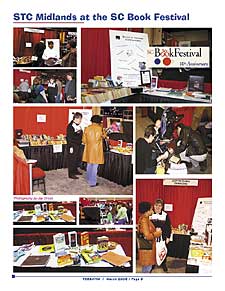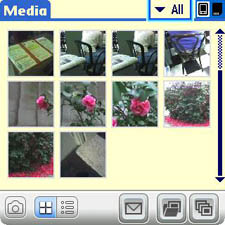 As a chilly drizzle soggified my Saturday, I found myself unwilling to take my digital SLR out for a stroll. It might (gasp!) get wet. Dutifully, I cruised to the convention center in my car, eyes peeled for a parking place. Finding none closer than my driveway, those three rainy blocks loomed. I decided to take along my Treo, which lives highly dry in a leather case and walk to the South Carolina Book Festival, leaving the Canon home.
As a chilly drizzle soggified my Saturday, I found myself unwilling to take my digital SLR out for a stroll. It might (gasp!) get wet. Dutifully, I cruised to the convention center in my car, eyes peeled for a parking place. Finding none closer than my driveway, those three rainy blocks loomed. I decided to take along my Treo, which lives highly dry in a leather case and walk to the South Carolina Book Festival, leaving the Canon home.
With considerable post processing, those Treo pictures now stand their ground alongside real-camera pictures that I got in the same place the next day (sunny and dry). Both times, the subject suffered from the center's mercury-vapor lighting, a worst-possible-scenario, and photographer�s nightmare. The image on the right shows the result--a picture page from a newsletter that I edit for the local chapter of the Society for Technical Communication.
Unfair comparison notwithstanding, the three Treo pictures (bottom left) hold their own against shots I did with my 6.4-megapixel digital Canon, which had the immense advantage of in-camera flash. Indeed, all the Treo pictures avail themselves of available light only, since the SmartPhone has no flash or support for one. Both sets of images required considerable post processing.
Sure, we're talking postage stamp sized images of not exactly LIFE magazine quality. Yet, they turned out a whole lot better than nothing, and for newsletter purposes they work fine. Post processing, Yay!
A couple more Treo 650 examples are in order. Okay, not in order, but so much fun to do. This series depicts the south steps of South Carolina's granite State House building.


Moving on
Convinced? Surprised? If you're not still grumping about the Treos' blurry lenses, let's explore the cameras, then move along to some tricks for using them to better advantage.
The Treos' user manuals don't go into much detail about the cameras. For the 650, you get instructions on how to click a picture, change resolution, and not much else. Treo 700w's manual isn't any more informative, even though it covers a more complex OS. Many topics go undocumented in both tomes.
The cameras are obviously cast from the same mold. The 700w version adds only some extra pixels - total 1.3 megapixels, 1280x1024 max--plus brightness adjustment and a few other frills relegated to Windows Mobile menus.
 The Treo 650 snaps your choice of 640x480 pixels better known as "VGA", or 320x240, which is a fourth of that. All of the above sport a 16-bit color palette--max 65,536 colors. The 700w shoots stills at 160x120, 240x180, 320x240, 640x480 or 1280x1024 pixels. Neither camera's focal length can change, and especially with camera lenses, change is good. No change is bad: stuff is either sharp or not, and no way to adjust where or whether the lens focuses.
The Treo 650 snaps your choice of 640x480 pixels better known as "VGA", or 320x240, which is a fourth of that. All of the above sport a 16-bit color palette--max 65,536 colors. The 700w shoots stills at 160x120, 240x180, 320x240, 640x480 or 1280x1024 pixels. Neither camera's focal length can change, and especially with camera lenses, change is good. No change is bad: stuff is either sharp or not, and no way to adjust where or whether the lens focuses.
Treos adjust the apparent "exposure" with an overall averaging scheme to compensate for high or low light levels. The shooting aperture, called "F-stop", won't budge. Attenuating brightness (700w) doesn't result in sharper pictures with more depth of field. They just look darker.
Both models also record motion, limited to 352x288 or 176x144. Treo "movies" are okay for emailing grandpa's centenary birthday smile, but they're in no danger of being snapped up for prime time. They suffer from the same shabby optics, single-minded focus, and fixed aperture as Treo stills. Alas, being comprised of many frames, the movies can't be as easily edited in post processing.
These factors account for much of what's wrong with the cameras, and explain the poor quality photos. Oh, and the lenses are fugitives from a blur factory. Now you know.
Making do
Well, that's what you get and that's all you get, so let's explore how you can work around, or work with, or somehow work against these limitations. First, a tip for viewing.
 When you start the camera application you see what the feeble lens "sees". However, you don't see all of it. The Treo's display chops off the camera's view where the controls appear at the bottom.
When you start the camera application you see what the feeble lens "sees". However, you don't see all of it. The Treo's display chops off the camera's view where the controls appear at the bottom.
Undocumented feature: When you view a stored Treo 650 picture it won't fit on the square screen--320x320. However, the view will scroll left and right. Touch the screen with the stylus and drag (gently!). The image moves with the stylus, revealing what's hidden. If you rotate a picture to vertical, the scroll is vertical, too.
Use "list" view to bring up an array of thumbnails to inspect the whole image. Better yet, copy the images to a computer and view them there, where you can work on them, too.
(The Treo 700w, with its 240x240-pixel display, takes a "zoom" approach. Press "z" to bring up the feature.)
Solutions >>
Copyright 1999-2016 TreoCentral. All rights reserved :
Terms of Use : Privacy Policy
TREO and TreoCentral are trademarks or registered trademarks of palm, Inc. in the United States and other countries;
the TreoCentral mark and domain name are used under license from palm, Inc.
The views expressed on this website are solely those of the proprietor, or
contributors to the site, and do not necessarily reflect the views of palm, Inc.
Read Merciful by Casey Adolfsson
 As a chilly drizzle soggified my Saturday, I found myself unwilling to take my digital SLR out for a stroll. It might (gasp!) get wet. Dutifully, I cruised to the convention center in my car, eyes peeled for a parking place. Finding none closer than my driveway, those three rainy blocks loomed. I decided to take along my Treo, which lives highly dry in a leather case and walk to the South Carolina Book Festival, leaving the Canon home.
As a chilly drizzle soggified my Saturday, I found myself unwilling to take my digital SLR out for a stroll. It might (gasp!) get wet. Dutifully, I cruised to the convention center in my car, eyes peeled for a parking place. Finding none closer than my driveway, those three rainy blocks loomed. I decided to take along my Treo, which lives highly dry in a leather case and walk to the South Carolina Book Festival, leaving the Canon home.


 The Treo 650 snaps your choice of 640x480 pixels better known as "VGA", or 320x240, which is a fourth of that. All of the above sport a 16-bit color palette--max 65,536 colors. The 700w shoots stills at 160x120, 240x180, 320x240, 640x480 or 1280x1024 pixels. Neither camera's focal length can change, and especially with camera lenses, change is good. No change is bad: stuff is either sharp or not, and no way to adjust where or whether the lens focuses.
The Treo 650 snaps your choice of 640x480 pixels better known as "VGA", or 320x240, which is a fourth of that. All of the above sport a 16-bit color palette--max 65,536 colors. The 700w shoots stills at 160x120, 240x180, 320x240, 640x480 or 1280x1024 pixels. Neither camera's focal length can change, and especially with camera lenses, change is good. No change is bad: stuff is either sharp or not, and no way to adjust where or whether the lens focuses.
 When you start the camera application you see what the feeble lens "sees". However, you don't see all of it. The Treo's display chops off the camera's view where the controls appear at the bottom.
When you start the camera application you see what the feeble lens "sees". However, you don't see all of it. The Treo's display chops off the camera's view where the controls appear at the bottom.